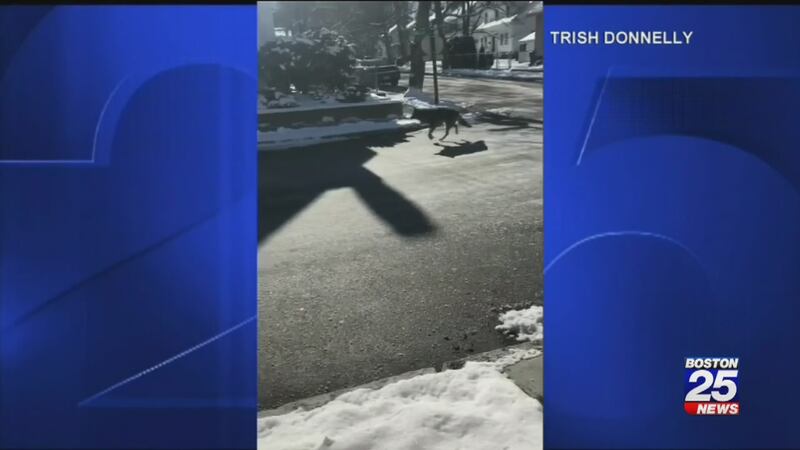WEST ROXBURY, Mass. — You've probably seen them, coyote sightings are being posted on social media nearly every day. Concerned neighbors say it's becoming a problem, others insist the animals are just a part of nature that we need to get used to.
Animal control has been receiving weekly calls about a coyote in West Roxbury since late December – the latest was just this Tuesday morning.
They are trying to trap the coyote, which has been limping through the neighborhood’s streets for months after injuring its leg. However, since it hasn’t been aggressive, they aren’t too worried.
Earlier on Tuesday, a woman was walking her dog in the Newfield Street area when she saw the coyote limping down the street.
"The coyote was very near to a woman with a relatively large dog, and I was happy to see that the coyote didn’t show any interest in them," said Amanda Kennedy, the Boston Director of Animal Care and Control. "He was just moving along."
Related: Haverhill family grieving after coyote snatches dog right in front of them
A couple who only lives a few streets away say they also saw the injured coyote on Tuesday morning.
Animal control says there are more coyotes roaming around this time of the year because it’s mating season. Those people who have seen the injured coyote are on edge.
"He was right smack in the middle of the road and I came out and took a couple snapshots of him," said John Dinatale of West Roxbury. "And he walked down the sidewalk and went right into my neighbor's yard, and not a care in the world."
"This is now six weeks since everyone has been talking about [the coyote] nonstop because he's been sighted so many times," added Dorothy Dinatale of West Roxbury.
"He was walking right across the house and as soon as I saw him walking I knew it was the coyote everyone was talking about because he walks and holds his right paw in the air, and he was much bigger than I thought he would be."
>>>MORE: Supermoon set to rise over state Tuesday night
While coyotes are now out in greater numbers, it's rare that they attack humans or leashed pets.
"I know that feels scary, but coyotes don't go after people," Kennedy said.
Still, pets that are unleashed even in a backyard are in danger, so it’s important, especially this time of the year, to leash your dogs and keep cats inside.
Another good tip is to hide anything else that coyotes might eat – so secure your trash. Also never feed them on purpose; animal control believes that the injured coyote might be sticking around in West Roxbury because someone is giving it food.
"A lot of times people will call and say, 'Can you pick this coyote up and put it somewhere better,' and it’s illegal to relocate wildlife and that’s for a number of reasons," Kennedy said. "For one, it’s not what’s best for the wildlife. They’re not going to survive if they’re relocated."
MassWildlife tips for residents:
Coyotes can thrive close to humans in suburban and urban areas. They require only a source of food, water, and cover. If you want to make your property less attractive to coyotes and avoid having any problems with these predators, follow these basic practices.
DON'T FEED OR TRY TO PET COYOTES:
Keep wild things wild! Feeding, whether direct or indirect, can cause coyotes to act tame and may lead to bold behavior. Coyotes that rely on natural foods remain wild and wary of humans.
SECURE YOUR GARBAGE
Coyotes raid open trash materials and compost piles. Secure your garbage in tough plastic containers with tight fitting lids and keep them in secure buildings when possible. Take out trash when the morning pick up is scheduled, not the previous night. Keep compost in secure, vented containers, and keep
barbecue grills clean to reduce attractive odors.
KEEP BIRD FEEDER AREAS CLEAN
Use feeders designed to keep seed off the ground, as the seed attracts many small mammals coyotes prey upon. Remove feeders if coyotes are regularly seen around your yard.
CLOSE OFF CRAWL SPACES
Coyotes will use areas under porches and sheds for resting and raising young. Close these areas off to prevent animals from using them.
DON’T LET COYOTES INTIMIDATE YOU
Don’t hesitate to scare or threaten coyotes with loud noises, bright lights, or water sprayed from a hose.
CUT BACK BRUSHY EDGES:
These areas provide cover for coyotes and their prey.
PROTECT LIVESTOCK AND PRODUCE:
Coyotes will prey on livestock. Various techniques, such as fencing, will protect livestock from predation. Clear fallen fruit from around fruit trees.
PET OWNERS:
Although free roaming pets are more likely to be killed by automobiles than by wild animals, coyotes
do view cats and small dogs as potential food, and larger dogs as competition. For the safety of your pets, keep them leashed at all times. Additionally, feed your pets indoors. Outdoor feeding can attract many wild animals.
Eastern coyotes are an important and valuable natural resource in Massachusetts. They are classified as a furbearer species, for which a regulated hunting season and management program have been established.
IF YOU ARE EXPERIENCING PROBLEMS WITH COYOTES OR HAVE QUESTIONS, VISIT
MASS.GOV/MASSWILDLIFE OR CONTACT YOUR NEAREST MASSWILDLIFE OFFICE:
- Central Wildlife District, West Boylston: (508) 835-3607
- Connecticut Valley Wildlife District, Belchertown: (413) 323-7632
- Northeast Wildlife District, Ayer: (978) 772-2145
- Southeast Wildlife District, Bourne: (508) 759-3406
- Western Wildlife District, Dalton: (413) 684-1646
- Field Headquarters, Westborough: (508) 389-6300
Cox Media Group








